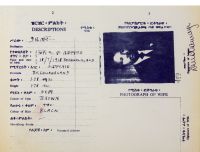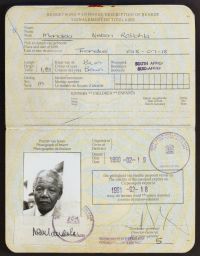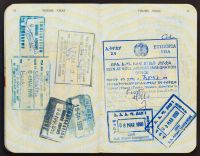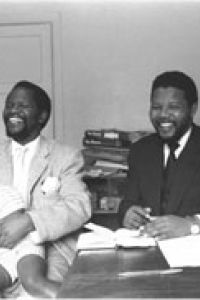March 4, 2008 – In June 1961, on the instructions of the ANC, Nelson Mandela went underground and spent many months hiding out in different locations, including Liliesleaf farm in Rivonia, north of Johannesburg – on the pretext of being a ”houseboy” or caretaker. “I had taken the name of David Motsamayi, the name of one of my former clients,” he wrote in Long Walk to Freedom.
In early 1962 he left the country, without South African travel documents, via Lobatse in then-Bechuanaland (now Botswana). Ostensibly he was to attend a conference of the Pan-African Freedom Movement for East, Central and Southern Africa (PAFMECSA), the forerunner of the Organisation of African Unity (OAU), in Addis Ababa, Ethiopia. In fact, he was also under instructions from the ANC and the Umkhonto weSizwe (MK) High Command to travel the continent to arrange political and economic support for the newly founded military wing.

Mr Mandela’s Ethiopian passport, issued in 1962, in the name of David Motsamayi.
(Image: Nelson Mandela Foundation)His travels also took him to Ethiopia, Tanganyika, Egypt, Tunisia, Morocco, Ghana and Senegal, amongst other countries.
Ethiopia made a great impression on Mr. Mandela. He wrote in his autobiography that it “has always held a special place in my own imagination and the prospect of visiting […] attracted me more strongly than a trip to France, England and America combined. I felt I would be visiting my own genesis, unearthing the roots of what made me an African.” In order to facilitate his travels he was issued with an Ethiopian passport – in the name of David Motsamayi.
After a further trip on to London and eight weeks’ military training in Addis Ababa, Mr Mandela was summoned back to South Africa by the ANC. He was arrested on August 5, 1962 in Howick, Natal. On August 7 he was formally charged with inciting African workers to strike and with leaving the country without valid travel documents, and was sent to Robben Island.

Mr Mandela’s first South African passport, issued eight days after his release from jail in 1990.
(Image: Nelson Mandela Foundation)His travels also took him to Ethiopia, Tanganyika, Egypt, Tunisia, Morocco, Ghana and Senegal, amongst other countries.
Ethiopia made a great impression on Mr. Mandela. He wrote in his autobiography that it “has always held a special place in my own imagination and the prospect of visiting […] attracted me more strongly than a trip to France, England and America combined. I felt I would be visiting my own genesis, unearthing the roots of what made me an African.” In order to facilitate his travels he was issued with an Ethiopian passport – in the name of David Motsamayi.
After a further trip on to London and eight weeks’ military training in Addis Ababa, Mr Mandela was summoned back to South Africa by the ANC. He was arrested on August 5, 1962 in Howick, Natal. On August 7 he was formally charged with inciting African workers to strike and with leaving the country without valid travel documents, and was sent to Robben Island.

Pages from Mr Mandela’s first South African passport show his extensive travels after his release from prison.
(Image: Nelson Mandela Foundation)In 1963, at the start of the Rivonia Trial, one of the 173 documents produced by the prosecution was a passport made out in the name of one David Motsamayi.
Mr Mandela’s first South African passport was issued to him on February 19, 1990 – eight days after he was released from 27 years in jail.
